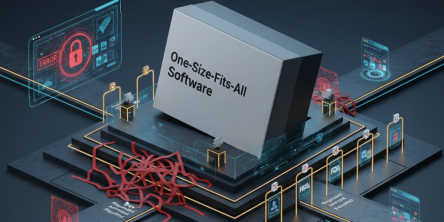Top 5 Data Integration Tools for Small Businesses to Big Enterprises

Every small and large enterprise require some actionable insights to grow their business. Moreover, to get such ideas, it is necessary to gather the data from various sources that stored in different technology platforms. A data integration process combines the data from multiple systems and extracts the relevant information. It helps companies to deal with big data without any hassle. However, it is vital to choose the right data integration tool depending on the type of data, formats, and industries.
The data integration tool transforms the vast amount of structured and unstructured data into informative, knowledgeable, and actionable insights. Such information helps you to get the full picture of the working and performance of your business and which efforts are working in driving industry profits. However, as there are a plethora of data integration tools available, it is challenging to find the perfect solution for your company. This article covers the most renowned data integration tools that will help you to pick up your option in a much faster time.
-
ODI (Oracle Data Integrator)
The ODI is a Java-based extremely flexible tool which works best for the big data integration for enterprises. It is designed as an ELT (Extract, Load, and Transform) tool; you can perform the transformation step either at the source or at the destination database as you want. It improves performance and reduces data integration costs, even for the heterogeneous systems.
Features:
-
Oracle Data Integrator contains a wide variety of pre-built integrations & connectors.
-
The lightweight designer of the web application helps to manage data integration task conveniently.
-
It offers service-oriented data integration & management for SOA environments.
-
-
Microsoft SQL Server Integration Services (SSIS)
The Microsoft SSIS is an enterprise data integration, transformation, and migration tool. It can extract, transform, and merge the data from various relational databases, XML data files, flat files, and other sources. This tool is cost-effective, flexible, and extensible, which you can integrate with other Microsoft add-ons and tools.
Features:
-
It has a graphical easy-to-use interface that helps users to deploy data warehousing solutions without writing code.
-
Along with ETA challenges, it can also do DBA activities, scripting, calling .exe files, and more.
-
You can deploy it on-premises or in the cloud. However, if you use Azure integration services, then it will work on the cloud only.
-
-
Dell Boomi
The Dell Boomi AtomSphere has robust data integration and management capabilities. This iPaaS (integration Platform as a Service) platform connects multiple applications and data across clouds and legacy systems. It is one of the best cloud-based data integration tools on the market, which helps organizations to reorganize their data silos into useful business insights.
Features:
-
Users can set up the data integration across different components on the data systems on-premises or in the cloud and can connect them into a ‘molecule’ for high availability.
-
It has a visual, drag-and-drop interface which helps users to integrate data repositories from multiple vendors easily.
-
It allows to automate complex data integrations and get real-time updates.
-
-
Informatica PowerCenter
Informatica PowerCenter is a leading enterprise data integration platform. It jumpstarts and accelerates complex data integration projects to deliver useful business insights quickly. This powerful tool follows a metadata drives approach to provide data mapping, input, transformation, and output functions.
Features:
-
The role-based tools and agile process helps to deliver data integration initiatives on time with accuracy.
-
Its automatic error logging and early warning features enable to detect problems at their early stage during the data integration process.
-
It provides relevant and timely data through its next-gen analytics function for operational efficiency.
-
-
Talend
The Talend data integration solution offers an open & scalable architecture that responds faster to business requests. It has a straightforward user interface that comes with excellent support for Hadoop in the integration process. The Talend Open Studio is available in free and commercial versions.Features:
-
It is perfect for the integration of software on any platform like Azure, AWS, Google, and more.
-
Talend is five times faster than MapReduce programming model.
-
It supports a vast number of functions without scripting and contains more than 450 software applications and tools.
-
Talend Open Studio can work on both the on-premise and cloud-based platforms.
-
It runs on Linux, Windows, OS X systems.
-
A robust data integration tool enables you to make connections between different data sources, systems, and applications without any hassle. Each of the data integration tool mentioned in this list has some overlapping and some unique qualities. You can easily pick up the most suitable device depending on your organization size, type of data and its use, your working sector (government, healthcare, or any other specialization), and the budget.
Similar Articles
Not long ago, the idea of multiple AI agents working together, each with a specific role, collaborating to solve problems, felt like science fiction.
In today’s data-driven world, choosing the right business intelligence (BI) platform can make or break your organization's analytics success.
We all know that companies today are no longer limited to a single physical location. Work processes are also no longer strictly isolated.
It is neither secret nor news that the mind-boggling pace of digital transformation around us has totally altered consumer expectations.
In the world of finance, speed and accuracy are everything. Decisions made a day late can cost millions, and delayed visibility into financial performance can leave even the best organizations blind to risks.
Discover the best tools to enhance employee recognition, boost morale, and create a more motivated, engaged workplace culture.
At first glance, off-the-shelf software appears to be a dream come true. They are quick to set up, cheaper upfront, and marketed as “universal.”
A modern business must continually adapt. This bit everyone seems to know.
The modern healthcare industry is undergoing a significant transformation. The models of healthcare that we are used to thus far are now making way for a more data driven approach









